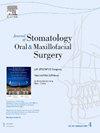浆细胞性牙龈炎:系统综述及诊断指南。
IF 2
3区 医学
Q2 DENTISTRY, ORAL SURGERY & MEDICINE
Journal of Stomatology Oral and Maxillofacial Surgery
Pub Date : 2025-10-01
DOI:10.1016/j.jormas.2025.102378
引用次数: 0
摘要
目的:浆细胞性牙龈炎是一种罕见的非牙菌斑引起的牙龈疾病,常伴有过敏反应。由于其罕见的许多问题,目前围绕其表现,病因和治疗。此外,其组织病理学与其他牙周疾病如牙周炎有许多相似之处。本系统综述旨在评估浆细胞性牙龈炎的病例,重点是其临床特征,可能的病因和治疗方法。方法:从1999年1月至2024年8月,在MEDLINE数据库、Scopus和Web of Science中检索英文出版物,使用以下术语:(浆细胞性龈口炎或非典型龈口炎或过敏性龈口炎)和(病因、临床特征、临床表现、治疗或管理)。所有临床表现为浆细胞性牙龈炎并经组织病理学检查证实的病例均被纳入研究。研究数据不明确,牙周炎或牙龈炎病例未首先治疗牙周病或不允许进行适当的检查被排除在外。结果:本组共纳入16篇文献19例,其中女性13例(68.420%),男性6例(31.57%),年龄跨度大,9 ~ 64岁。所有病例的上颌骨前部均受影响。所有病例均表现为牙龈红斑,多为弥漫性受累。轻微刺激出血和嘴唇肿胀是另一个临床症状。治疗方式不同,从停止可能的病因,局部药物,去除病变和光生物调节。结论:在出现牙龈炎症的情况下,首先要排除牙龈炎、牙周炎、炎症性牙龈肿大等其他疾病。浆细胞性牙龈炎的诊断应基于详细的既往病史、准确的临床评估、实验室、显微镜和免疫组织化学评估。本文章由计算机程序翻译,如有差异,请以英文原文为准。
Plasma cell gingivitis: A systematic review and guideline to diagnosis
Objective
Plasma cell gingivitis is a rare non-dental plaque-induced gingival disease often associated with hypersensitivity reactions. Due to its rarity many questions present around its presentation, etiology, and treatment. Moreover, its histopathology has many similarities with other periodontal condition such as periodontitis. The present systematic review aimed to assess the cases of plasma cell gingivitis focusing on its clinical features, possible etiologic factors, and treatment modalities.
Methods
The search was done in The MEDLINE database, Scopus, and Web of Science from January 1999 until August 2024 for English publications using the following terms: (plasma cell gingivitis OR atypical gingivostomatitis OR allergic gingivostomatitis) AND (etiology OR clinical feature OR clinical manifestation OR treatment OR management). Any presented cases with clinical manifestation of plasma cell gingivitis confirmed with histopathologic assessment were included. Studies with unclear data, periodontitis or gingivitis cases which was not first treated for periodontal disease or not allowed for proper check-ups were excluded.
Results
Sixteen articles comprise 19 cases included in this review from them 13 were female (68.420 %) and 6 were male (31.57 %) with wide age range from 9 to 64 years. Anterior of the maxilla were affected in all cases. Erythematous gingiva are presented in all cases which were mostly diffuse involvement. Bleeding on slight provocation and lip swelling were another clinical signs. Treatment modalities were different from discontinuing possible etiologic factors, topical drugs, to removing the lesion, and photobiomodulation.
Conclusion
In cases of gingival inflammation, it is important to first rule out other diseases such as gingivitis, periodontitis, and inflammatory gingival enlargement. The diagnosis of plasma cell gingivitis should be based on a detailed past medical history, accurate clinical evaluation, laboratory, microscopic, and immunohistochemical assessment.
求助全文
通过发布文献求助,成功后即可免费获取论文全文。
去求助
来源期刊

Journal of Stomatology Oral and Maxillofacial Surgery
Surgery, Dentistry, Oral Surgery and Medicine, Otorhinolaryngology and Facial Plastic Surgery
CiteScore
2.30
自引率
9.10%
发文量
0
审稿时长
23 days
 求助内容:
求助内容: 应助结果提醒方式:
应助结果提醒方式:


